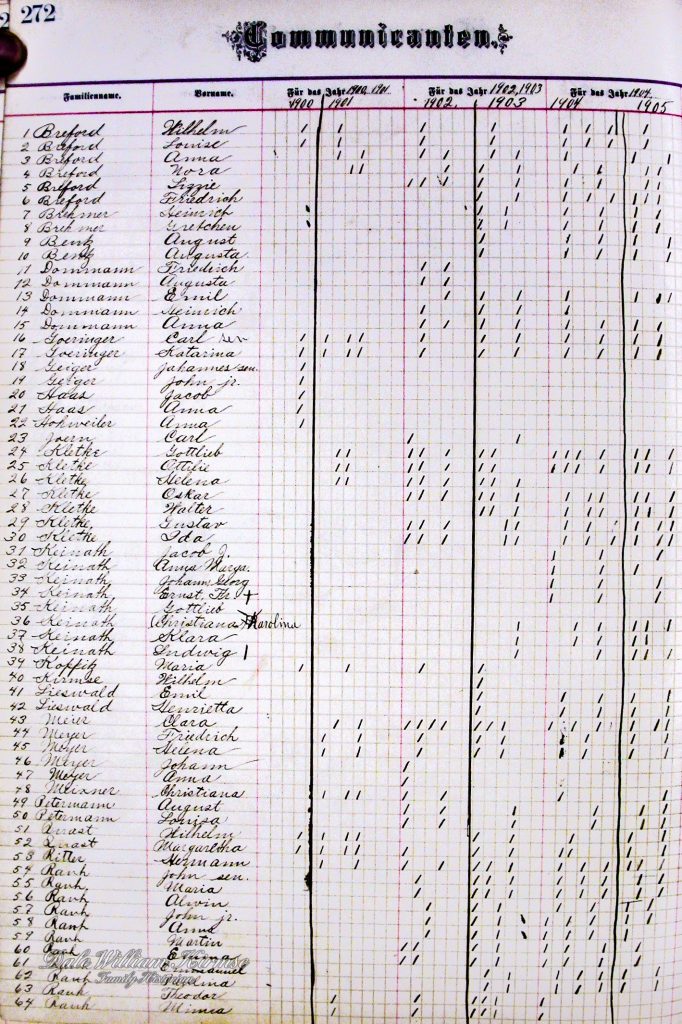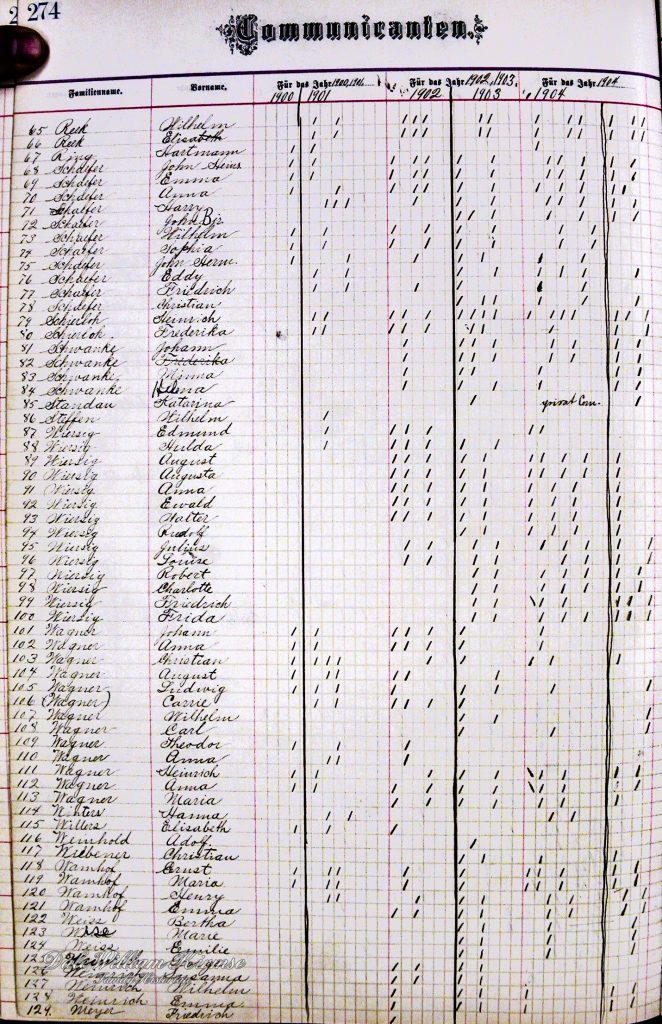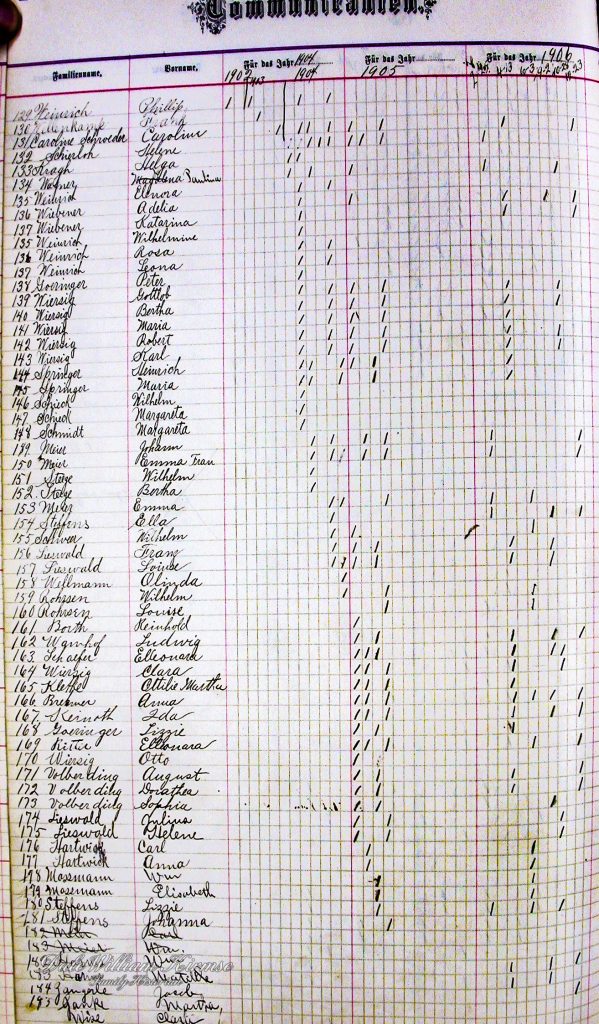Communicant records are available from 1901 to 1914 when pastor Herman Meyer served the Zion Lutheran Church. However, only the first five years are shown here so as to correspond with the 1904 Zion Lutheran Church – Alva Membership.



Discussion
Communion
To understand the communicant records, it is appropriate to explain the practice of communion at Zion Lutheran Church – Alva. For Lutherans in general, confession and absolution are considered proper preparation for receiving the sacrament. Congregations in the Lutheran Church–Missouri Synod practices “close” or “closed communion“, meaning that Lutheran catechetical instruction is required for all people before receiving the Eucharist. At the time these communicant records were prepared, the Zion congregation required that one speak to the pastor before the service to confirm their common faith.
Completeness of the Records
The record is believed to be incomplete. The first records are from late 1900. The Zion Lutheran – Alva was organized officially on May 21 of 1899 under the leadership of missionary J. Lill. It is assumed that Rev Lill administered communion when he was in Alva and the first communion services were likely before late 1900. Rev. Herman Meier was installed September 9, 1901 and possibly a communion service was held at that service. Communion was held quarterly through 1905 and in 1906 began to be held every other month. Later, communion was held monthly.
Changes Over the Years
While the Lutheran doctrine of the real presence, as formulated in the Augsburg Confession is maintained. How the pastor administers the Lord’s Supper for the congregation has changed. Initially, only the pastor was allowed to administer the communion sacraments. Over time this requirement along with other traditions have been revised.
On January 28, 1940, a motion was made and carried to empower Vicar Gumz to administer the sacraments and serve the congregation in every capacity as its pastor, save the power to perform marriages. Rev. Hoyer had taken sick that year which prompted this decision.[1]
An interesting decision was made on January 18, 1948, stating that men and women could attend the Lord’s Supper together. This followed the allowance for men and women to sit together on the same side of the church which had come some years before. By that time, traditions of the past had already largely been overturned. Men and women no longer were sitting on separate sides of the church, with the children down front, as had been the case in days gone by. The division of men and women was overturned largely because of the pioneering attitude of Walter and Anna Mae Ritter and other couples in the late 1920s. Anna Mae, raised in another denomination, joined the church when they married but refused to submit to the practice which would prohibit her from worshipping alongside her husband. So the couple became pioneers in their small way and a tradition gave way to changing times.
Other changes took place during the early 1970s.
On January 18, 1970, an announcement was made to the effect that lay assistance would be permitted in the distribution of communion. The greatest impetus for this change came from the fact that district-wide pastors’ conferences had discontinued the celebration of the Lord’s Supper from their bi-annual meetings, therefore eliminating the only opportunity the pastor would have to receive communion himself. With lay help, the pastor would be enabled to partake of the Lord’s body and blood with the rest of the congregants.
On February 15, 1970, the voters decided to go back to two services on Sunday again. In addition, communion practices were altered. It was proposed and decided upon that we could and ought to have the opportunity to celebrate the Lord’s Supper within the worship service with a greater frequency than once a month.
Use of the Records
The record provides a visual display of when someone joined the church and when they possibly left the church. On pages 1 and 2 there are instances where a number of communicants with the same surname begin taking communion at the same time – typically this is when the family joined Zion Lutheran. On page 3 where communicants with different surnames began taking communion at the same time was probably a confirmation class taking their first communion.
Only members of Zion and sister churches participate in communion. Hence, the communicant records include not only members of Zion Lutheran – Alva, but also visitors from sister cogregations. For example, Wilhelm “William” Kirmse participated in taking communion in 1903 but did not become a member of Zion until 1911 when he moved to Alva from Shattuck, Oklahoma.
Jacob Haas was one of the “possible” founding fathers mentioned previously and is listed as a member of Zion in 1904. He and his wife Anna are recorded as taking communion in 1901 but none after that. A disciplinary case recorded in church minutes of the January 1, 1904, meeting states that Jacob Haas was “stricken from membership” since “he doesn’t come to church at all.”[1]
Notes
- Zion Lutheran Church – Alva, Oklahoma 100 year celebration booklet “Zion Lutheran Church 1899-1999 Alva, OK”. 1999.
